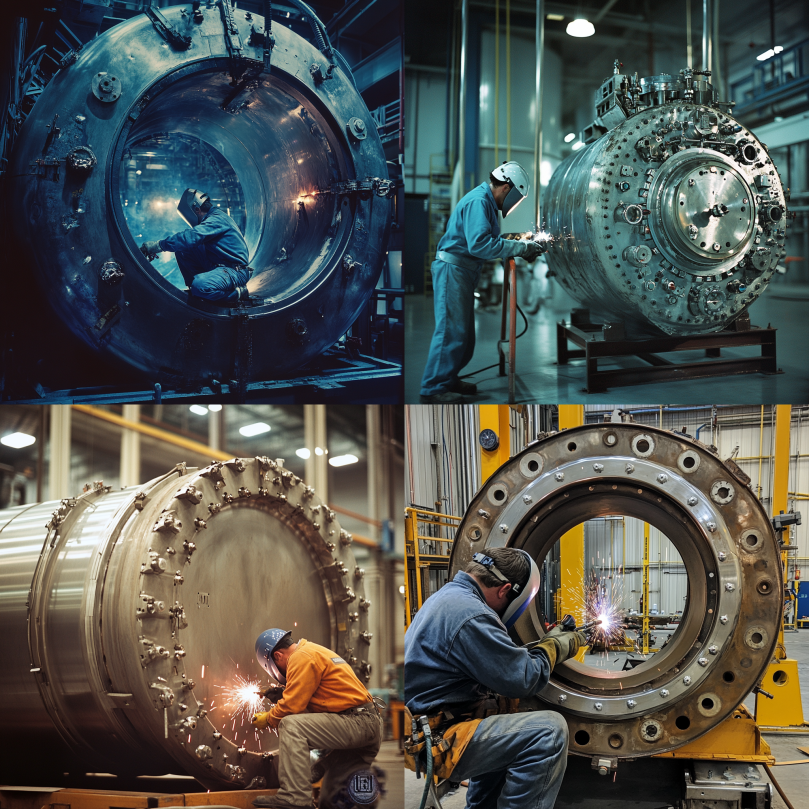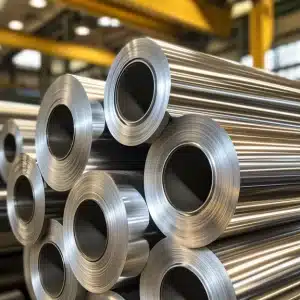
Why Welding for Vessel Fabrication Is Critical in U.S. Industry
The role of welding for vessel fabrication in America is undeniably one of the most essential elements in ensuring the structural integrity, operational safety, and code compliance of pressure vessels. Welding plays a critical role in joining the various components of a pressure vessel, ensuring that each seam, joint, and reinforcement is securely bonded. Furthermore, welding is key to sealing joints, reinforcing stress points, and creating a leak-proof containment that can withstand extreme pressure, temperature, and environmental conditions. Consequently, the quality of welding directly impacts the performance and longevity of the vessel, making it a cornerstone in the design and manufacturing of pressure vessels across various industries. Ultimately, without welding, the pressure vessels would fail to meet the necessary operational and safety standards.
Types of Welding Used in Pressure Vessel Fabrication
The role of welding for vessel fabrication in America involves a range of advanced and highly specialized welding techniques. Since welding must account for key variables such as material composition, wall thickness, joint configuration, and the vessel’s intended operational environment, different welding processes—such as TIG (Tungsten Inert Gas), MIG (Metal Inert Gas), submerged arc welding, and electron beam welding—are commonly used, depending on the specific requirements of the application. These precision-driven methods ensure that pressure vessels maintain structural integrity under extreme conditions, including high pressure, corrosive chemicals, and wide temperature variations. Thus, welding for vessel fabrication is not only essential for strength and leak prevention but also for long-term durability, regulatory compliance, and overall operational safety.
Shielded Metal Arc Welding (SMAW)
Also known as stick welding, SMAW is used for field repairs and thick steel components. It’s reliable but slower compared to other processes.
Gas Tungsten Arc Welding (GTAW/TIG)
This process offers precision and is commonly used for stainless steel and thinner materials where purity and aesthetics are essential.
Gas Metal Arc Welding (GMAW/MIG)
Ideal for high-speed production, GMAW provides clean welds and is used in many carbon steel pressure vessel applications.
Submerged Arc Welding (SAW)
Highly efficient for long, straight seams in large pressure vessels. It delivers deep penetration and strong welds.
Flux-Cored Arc Welding (FCAW)
An excellent option for welding thick sections and outdoors. FCAW is used in large vessel assemblies where productivity is crucial.
Welding Standards and Compliance Requirements
The role of welding for vessel fabrication in America is subject to stringent codes and standards, which are necessary to ensure safety, quality, and compliance with industry regulations. For instance:
- ASME Section IX: Governs welding procedures and welder qualifications.
- ASME Section VIII: Addresses the design, fabrication, and testing of pressure vessels.
- National Board Inspection Code (NBIC): Applies to repairs and alterations.
- API Standards: Especially relevant for vessels in the oil, gas, and chemical sectors.
Thus, certified welders and approved welding procedures are required to comply with these regulations, thereby ensuring each weld can withstand operating stress and fatigue. In turn, these regulations ensure that the welded components meet all operational requirements under varying conditions.
Material Considerations in Pressure Vessel Welding
The role of welding for vessel fabrication in America varies depending on the material being welded. This ensures that proper strength, durability, and compliance with safety standards are achieved. For example:
- Carbon Steel: Common and easy to weld using MIG or SAW.
- Stainless Steel: Requires TIG welding and strict cleanliness to avoid contamination.
- Duplex Stainless & Unfamiliar Alloys: Demand controlled environments and specialized electrodes.
- Clad Materials: Welding must not damage the lining, which requires dual-process methods.
In addition, proper filler metals, preheat/post-weld treatments, and joint preparation vary significantly between materials to avoid issues such as cracking, porosity, and weld failure. Therefore, selecting the right approach based on material composition is essential for the success of the fabrication process.
Weld Joint Types in Pressure Vessel Construction
The role of welding for vessel fabrication in America also includes creating joint configurations that enhance structural integrity, ensuring the vessel can withstand high pressure and extreme conditions. For instance:
- Butt Joints: Common in shell-to-shell and head-to-shell connections.
- Fillet Welds: Used in structural brackets and attachments.
- Full Penetration Welds: Ensure internal containment in high-pressure systems.
- Corner and Edge Welds: Found in nozzle assemblies and access hatches.
Furthermore, each joint undergoes detailed inspection using NDE methods such as radiographic (RT), ultrasonic (UT), magnetic particle (MT), and dye penetrant (PT) testing. As a result, the welding process is thoroughly verified for its strength and durability.
Challenges and Solutions in Pressure Vessel Welding
The role of welding in fabricating pressure vessels in America comes with several challenges:
- Distortion from heat input
- Hydrogen-induced cracking
- Weld porosity and inclusions
- Access limitations for complex internals
Solutions include:
- Using heat control and sequencing techniques
- Preheating thicker sections
- Post-weld heat treatment (PWHT)
- Employing robotic and automated welding systems for consistency
Technological Advancements in Welding for Pressure Vessels
The role of welding for vessel fabrication in America continues to evolve with technology, incorporating advanced techniques such as automated welding and robotic systems for improved precision and efficiency.
- Automated Welding Systems: Reduce errors and speed up production
- Orbital Welding: Ideal for small-diameter, high-purity systems in pharma and biotech
- Laser Welding: Emerging in specialized vessels for high-precision applications
- Digital Weld Monitoring: Ensures quality control and traceability
Welding in Pressure Vessel Fabrication
In conclusion, the role of welding for vessel fabrication in America is central to delivering high-performance, code-compliant, and long-lasting vessels. From material fusion and pressure containment to corrosion resistance and longevity, skilled welding is at the heart of fabrication. As industries demand more advanced, custom-built pressure vessels, the quality of welding will undoubtedly remain a cornerstone of American manufacturing excellence. Consequently, as technology advances and more stringent standards are introduced, the welding techniques used in vessel fabrication will continue to evolve and adapt to meet the challenges of modern industrial applications.
Need a reliable partner?
Red River specializes in the design and manufacturing of pressure vessels. We also fabricate related items such as prefabricated spools and skid packages.
Reach out to us today and experience the Red River difference. Where American-made products and American Values come together, we care more.
Frequently Asked Questions
1. Why is welding so important in pressure vessel fabrication?
Welding ensures pressure integrity, structural strength, and leak-proof performance in vessels.
2. What’s the most common welding process for pressure vessels?
SMAW and SAW are common for carbon steel; TIG is preferred for stainless steel.
3. Are welds inspected for quality?
Yes, all critical welds undergo non-destructive testing (NDT) to meet ASME and NBIC standards.
4. Can pressure vessel welding be automated?
Absolutely. Automated systems increase consistency and reduce human error in complex welds.
5. Do different materials require different welding methods?
Yes. Each material—from carbon steel to unfamiliar alloys—needs unique techniques, filler metals, and treatments.
Key Takeaways
- The role of welding in fabricating pressure vessels in America is essential for structural integrity and compliance.
- Multiple welding methods are used depending on material, thickness, and design.
- Compliance with ASME, NBIC, and API standards ensures safety and quality.
- Weld joints are selected and tested based on operational pressures and geometry.
- Modern welding technologies improve precision, productivity, and quality control.
Related Blog Post

Marine-Grade vs Standard Stainless Steel

Pros and Cons of Vertical Integration

How to Dry Desiccant Properly and Regain Its Effectiveness

Why Do Gas Turbines Need Fuel Water Separator Vessels, Red River

